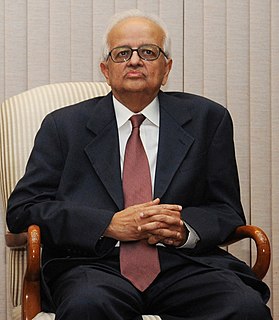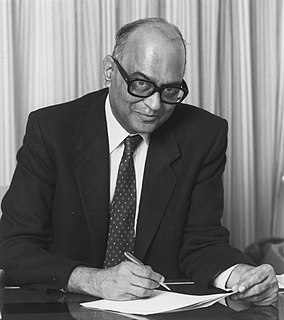
The Reserve Bank of India (RBI) is India's central bank and regulatory body under the jurisdiction of Ministry of Finance, Government of India. It is responsible for the issue and supply of the Indian rupee and the regulation of the Indian banking system. It also manages the country's main payment systems and works to promote its economic development.

Bimal Jalan is a former Governor of Reserve Bank of India and was a nominated member of the Upper House of India's Parliament, the Rajya Sabha during 2003–2009.

Sir James Braid Taylor, KCIE was the second Governor of the Reserve Bank of India, holding office from 1 July 1937 until his death on 17 February 1943. He succeeded Sir Osborne Smith who was the Governor from 1 April 1935 to 30 June 1937. He was appointed a CIE in the 1933 New Year Honours List, knighted in the 1935 Silver Jubilee and Birthday Honours List and further appointed a KCIE in the 1939 Birthday Honours List.
Bhaskar Namdeo Adarkar was the ninth Governor of the Reserve Bank of India from 4 May 1970 to 15 June 1970. His term was the second-shortest after Amitav Ghosh who had served for only 20 days. His term was short since he was filling in as interim before S. Jaganathan took over.
Sarukkai Jagannathan was the tenth Governor of the Reserve Bank of India from 16 June 1970 to 19 May 1975.

Ram Narain Malhotra popularly known as R. N. Malhotra was the seventeenth governor of the Reserve Bank of India (RBI), serving from 4 February 1985 to 22 December 1990.
Maidavolu Narasimham was the thirteenth governor of the Reserve Bank of India (RBI) from 2 May 1977 to 30 November 1977. For his contributions to the banking and financial sector in India, he is often referred to as the father of banking reforms in India. Some of the reforms attributed to his recommendations include changes to banking structures, introduction of private sector banks, creation of asset recovery funds, rural banking, changes to capital adequacy and provisioning standards, technology upgradation and modernization of public sector banks, and capital market linked banking reforms.
K. R. Puri was Governor of the Reserve Bank of India from 20 August 1975 to 2 May 1977. He was the Chairman and Managing Director of the Life Insurance Corporation of India prior to his appointment as Governor of the RBI.
Paresh Chandra Bhattacharya OBE was the seventh Governor of the Reserve Bank of India from 1 March 1962 to 30 June 1967. Unlike his predecessors he was a member of the Indian Audits and Accounts Service (IA&AS). He was appointed an Officer of the Order of the British Empire (OBE) in the 1946 New Year Honours. He served as Secretary in the Finance Ministry and later as Chairman of State Bank of India before his appointment as the Governor.
K. G. Ambegaokar was the fifth Governor of the Reserve Bank of India from 14 January 1957 to 28 February 1957. He was a member of the Indian Civil Service, and served as Finance Secretary before his appointment as Deputy Governor of the RBI. On the resignation of B Rama Rau he took over as the Governor. His tenure was the third-shortest after B. N. Adarkar (42) and Amitav Ghosh (20). Compared to the latter two Governors Ambegaonkar's signature as RBI Governor does not appear on any Indian Rupee note, but his signature as Finance Secretary appeared on the second, third, and fourth Rupee one notes issued after independence.
Lakshmi Kant Jha, MBE, born in Bhagalpur district, Bihar, or L. K. Jha as he was called, was the eighth Governor of the Reserve Bank of India from 1 July 1967 to 3 May 1970.

Indraprasad Gordhanbhai Patel popularly known as I. G. Patel, was an Indian economist and a career civil servant who served as the fourteenth Governor of the Reserve Bank of India from 1 December 1977 to 15 September 1982.

Chakravarthi Rangarajan is an Indian economist, a former Member of Parliament and 19th Governor of the Reserve Bank of India. He is the former Chairman of the Prime Minister's Economic Advisory Council, he resigned the day the UPA lost power. He is also the Chairman of the Madras School of Economics; former President of the Indian Statistical Institute; the Founding Chairman of the CR Rao Advanced Institute of Mathematics, Statistics and Computer Science; former Chancellor of the University of Hyderabad; and a professor in Ahmedabad University.
Yaga Venugopal Reddy is an Indian economist and a retired Indian Administrative Service (IAS) officer of the 1964 batch belonging to Andhra Pradesh cadre. Reddy served as governor of the Reserve Bank of India (RBI) from 6 September 2003 until 5 September 2008.

The Gandhi Series of banknotes are issued by the Reserve Bank of India (RBI) as the legal tender of Indian rupee. The series is so called because the obverse of the banknotes prominently display the portrait of Mahatma Gandhi. Since its introduction in 1996, this series replaced all Lion Capital Series banknotes issued before 1996. The Reserve Bank of India (RBI) introduced the series in 1996 with 10 and 500 rupee banknotes.

The Indian 100-rupee banknote is a denomination of the Indian rupee. It has been in continuous production since Reserve Bank of India took over the functions of the controller of currency in India in 1935. The present ₹100 banknote in circulation is a part of the Mahatma Gandhi Series. These notes are in circulation along with the Mahatma Gandhi New Series of banknotes which were introduced in July 2018.

The Indian 10-rupee banknote is a common denomination of the Indian rupee. The ₹10 note was one of the first notes introduced by the Reserve Bank of India as a part of the Mahatma Gandhi Series in 1996. These notes are presently in circulation along with the Mahatma Gandhi New Series which were introduced in January 2018, this is used alongside the 10 rupee coin.

The Indian 2000-rupee banknote (₹2000) is a denomination of the Indian rupee. It was released by the Reserve Bank of India (RBI) on 8 November 2016 after the demonetisation of ₹500 and ₹1000 banknotes and has been in circulation since 10 November 2016. It is a part of the Mahatma Gandhi New Series of banknotes with a completely new design.
The Mahatma Gandhi New Series of banknotes are issued by the Reserve Bank of India (RBI) as the legal tender of the Indian rupee, intended to replace the Mahatma Gandhi Series of banknotes. Announced on 8 November 2016, it followed the demonetisation of ₹500 and ₹1000 banknotes of the original Mahatma Gandhi Series. Similar to the preceding series of banknotes, the obverse of the Mahatma Gandhi New Series banknotes also prominently displays the portrait of Mahatma Gandhi. The logo of Swachh Bharat Abhiyan is also printed on the back of the banknotes of this series.










